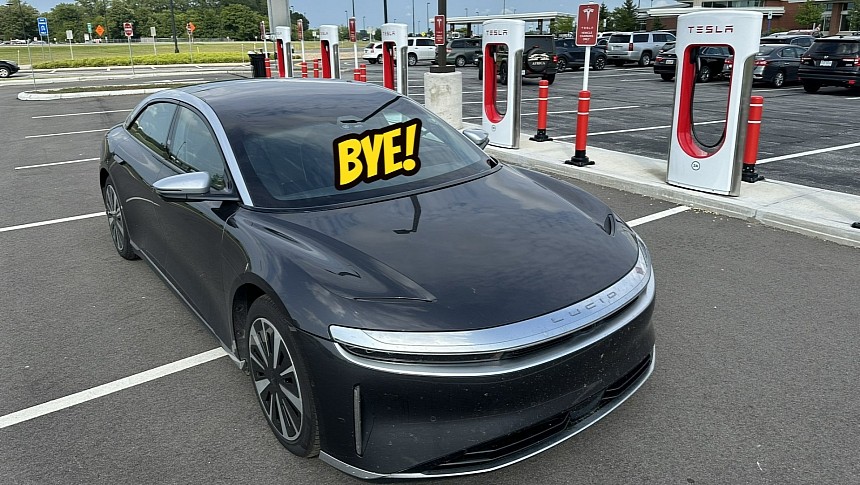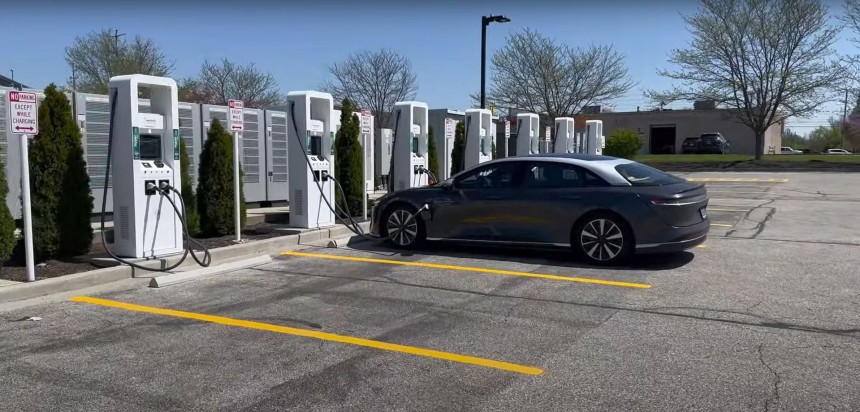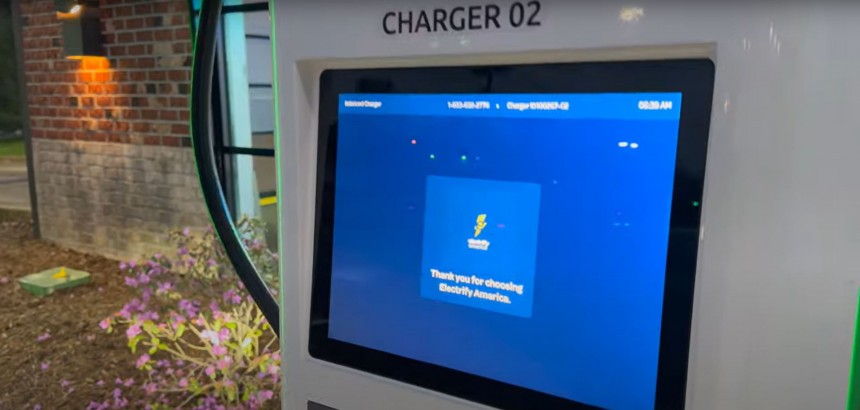There's no denying that Lucid makes fantastic all-electric vehicles. The Air comes in many flavors, and it's one of the fastest vehicles out there, both in terms of speed and charging capabilities. However, when you acquire an EV, you're also buying into the DC charging network. For this owner, the seemingly never-ending problems with replenishing the high-voltage energy storage unit have forced them to get rid of the posh EV. There's a lesson for all of us and automakers to learn here.
A Lucid Air Grand Touring owner announced that he is selling the vehicle mainly because of troubles experienced while needing a rapid charging session. The man doesn't name any names, but the vehicle he's getting rid of has been featured on autoevolution before.
That's how we can tell you that the problem isn't the CCS Combo 1 connector specifically but Electrify America's inability to make its stalls work seamlessly with EVs boasting battery architectures that have a voltage of 800V or more.
The particular Air Grand Touring that left Colorado for California on a hauler has been used in three different tests requiring the Dieselgate-born high-power charging network to work properly.
The first happened in April when the Out of Spec team attempted to set a new EV Cannonball record. They would have done it, but the inconsistent charging experience put a serious dent in their plans.
Three months later, in July, the same car was taken on a 2,000-mile road trip from Colorado to Connecticut. The so-called Signet Surge phenomenon was present yet again. On top of oscillating charging speeds, broken or mislabeled electricity dispensers were another problem they faced.
Most recently, the Air Grand Touring was put to another interesting test. It raced against a Tesla Model S Plaid and an entry-level single-motor Porsche Taycan RWD. Again, DC fast-charging destroyed the Air's chances of finishing the 1,600-mile trip first. Supercharging was much simpler and more reliable, even though the plug required a wet rag on it because it was getting hotter and throttling the charging speed.
There's nothing wrong with the Lucid Air. In fact, it's one of the best cars on sale today. It has its shortcomings regarding software, but Lucid didn't have 20 years to smooth everything out. Moreover, updates are possible via a simple over-the-air (OTA) push.
The issue lies with CCS-equipped fast-charging providers like Electrify America. And it's not just broken chargers or oscillating charging speeds but also weird errors like plugging in to get some electrons and someone else being billed for your session.
And you don't even have to believe us. Important automakers like Ford, General Motors, Mercedes-Benz, Volvo, Honda, Nissan, and even Rivian or Fisker didn't just wake up one day and decide they wanted to adopt Tesla's charging port (the NACS) and give the EV maker more customers. They did so because the non-Supercharger options were either unreliable or not available near where their customers lived, which could've seriously hurt their sales in the long run.
This Air Grand Touring owner got rid of his car for a similar reason and is now exploring returning to owning a Model X. They previously had a 2016 P60D model, and are now thinking about buying a much-improved 2023 dual-motor unit.
And how couldn't he? The two-row five-seater EV costs $79,990, qualifies for the EV tax credit, comes as standard with the tow package and Autopilot, and you can pick any paint you might want at no extra cost. Buying the Model X may have some fit-and-finish shortcomings sometimes, but you at least know that when charging at home is impossible, there won't be an issue with finding a working Supercharger.
Tesla did many questionable things and might still have some left in the pipeline, but what it does right is cars, software, and taking care of its high-power charging network.
Still, Electrify America is under new leadership and still has a chance at fixing everything before its brand reputation is damaged beyond repair.
That's how we can tell you that the problem isn't the CCS Combo 1 connector specifically but Electrify America's inability to make its stalls work seamlessly with EVs boasting battery architectures that have a voltage of 800V or more.
The particular Air Grand Touring that left Colorado for California on a hauler has been used in three different tests requiring the Dieselgate-born high-power charging network to work properly.
The first happened in April when the Out of Spec team attempted to set a new EV Cannonball record. They would have done it, but the inconsistent charging experience put a serious dent in their plans.
Three months later, in July, the same car was taken on a 2,000-mile road trip from Colorado to Connecticut. The so-called Signet Surge phenomenon was present yet again. On top of oscillating charging speeds, broken or mislabeled electricity dispensers were another problem they faced.
There's nothing wrong with the Lucid Air. In fact, it's one of the best cars on sale today. It has its shortcomings regarding software, but Lucid didn't have 20 years to smooth everything out. Moreover, updates are possible via a simple over-the-air (OTA) push.
The issue lies with CCS-equipped fast-charging providers like Electrify America. And it's not just broken chargers or oscillating charging speeds but also weird errors like plugging in to get some electrons and someone else being billed for your session.
And you don't even have to believe us. Important automakers like Ford, General Motors, Mercedes-Benz, Volvo, Honda, Nissan, and even Rivian or Fisker didn't just wake up one day and decide they wanted to adopt Tesla's charging port (the NACS) and give the EV maker more customers. They did so because the non-Supercharger options were either unreliable or not available near where their customers lived, which could've seriously hurt their sales in the long run.
And how couldn't he? The two-row five-seater EV costs $79,990, qualifies for the EV tax credit, comes as standard with the tow package and Autopilot, and you can pick any paint you might want at no extra cost. Buying the Model X may have some fit-and-finish shortcomings sometimes, but you at least know that when charging at home is impossible, there won't be an issue with finding a working Supercharger.
Tesla did many questionable things and might still have some left in the pipeline, but what it does right is cars, software, and taking care of its high-power charging network.
Still, Electrify America is under new leadership and still has a chance at fixing everything before its brand reputation is damaged beyond repair.
Bye Bye Lucid. Amazing car. pic.twitter.com/xqtJGp5OoA
— Out Of Spec Dave (@OutofSpecDave) September 21, 2023













